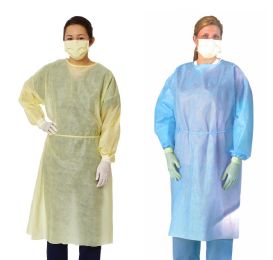









Disposable Isolation Gowns are being used by medical professionals in more than 80% of hospitals and medical facilities for medium to high-risk chances of contamination based on the nature of the patient interaction. A level 2 isolation gown is usually worn for routine patient care with an anticipated degree of contact with infectious materials. When the potential for exposure to blood and body fluids during suturing, blood draws, inserting I.V. lines, and in the ICU, a level 2 isolation gown is recommended.
By design, isolation gowns have openings in the back, coverage to the mid-calf only, and do not provide continuous whole-body protection. Surgical isolation gowns are used when there is a medium to high risk of contamination and when larger critical zones need coverage. A recommended isolation gown with more coverage that encompasses the back would be the Reusable Level 2 AAMI Isolation Gown, than traditional surgical gowns. All areas of surgical isolation gown except cuffs, hems, and bindings are considered critical zones of protection and must meet the highest liquid barrier protection level for which the gown is rated. All seams must have the same liquid barrier protection as the rest of the gown and the fabric of the surgical isolation gown should cover as much of the user’s body as is appropriate for the intended use.
Why Do HCWS Use Protective Isolation Gowns?
To protect medical staff from blood droplets and other solid or liquid debris during a patient’s checkup, an isolation gown is needed. The design of protective clothing, for example, isolation gowns, coveralls, and surgical gowns should be worn by healthcare workers and patients when a threat of exposure exists from receiving or transmitting diseases caused by viruses such as hepatitis B, hepatitis C, human immunodeficiency virus, Ebola and others.
The FDA and the ANSI/AAMI have created a “liquid barrier performance and classification of protective apparel and drapes intended for use in health care facilities” to differentiate the various types of isolation gowns needed for different situations.
Level 1: Minimal risk, to be used, for example, during basic care, standard isolation, cover gown for visitors, or in a standard medical unit.
Level 2: Low risk, to be used, for example, during the blood draw, suturing, in the Intensive Care Unit (ICU), or a pathology lab.
Level 3: Moderate risk, to be used, for example, during arterial blood draw, inserting an intravenous (IV) line, in the Emergency Room, or for trauma cases
Level 4: High risk, to be used, for example, during long, fluid intense procedures, surgery, when pathogen resistance is needed or infectious diseases are suspected (non-airborne).